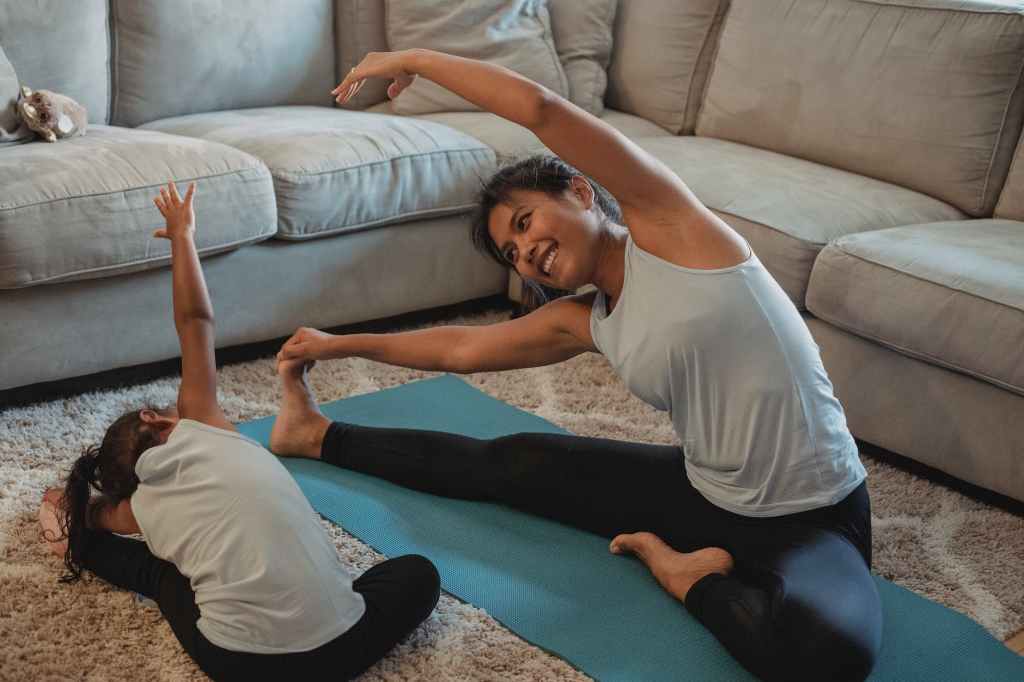There are many different types of exercise that can help to improve physical and mental health. Some of the most common types of exercise include:
Aerobic exercise: Also known as cardio, this type of exercise involves sustained physical activity that raises the heart rate and improves cardiovascular health. Examples include running, cycling, swimming, and dance.

Strength training: This type of exercise involves using resistance to build and maintain muscle mass and strength. Examples include weightlifting, resistance band/bodyweight exercises.
Flexibility and balance exercises: These types of exercises help to improve flexibility and balance, reduce the risk of falls, and enhance overall physical function. Examples include yoga, tai chi, and stretching exercises.
High-intensity interval training (HIIT): This type of exercise involves alternating short periods of intense exercise with periods of recovery, and is designed to improve cardiovascular endurance and boost calorie burn.
Mind-body exercises: This type of exercise involves physical activity combined with mental focus, breathing techniques, and meditation. Examples include yoga, tai chi, and Pilates.
Team sports: These types of exercise involve playing a sport as part of a team, and can improve physical fitness, teamwork skills, and social interaction. Examples include basketball, soccer, and volleyball.
In conclusion, there are many different types of exercise that can be beneficial for physical and mental health. It’s important to find an exercise routine that you enjoy and that fits your individual needs and goals. You may also want to vary your exercise routine to avoid boredom and to challenge your body in different ways.
Physical activity help in relieving stress and improve mental health. Here are some of the best exercises for mental stress:
Aerobic exercise: Regular aerobic exercise has been shown to reduce symptoms of anxiety and depression and improve mood. Examples include running, cycling, and swimming.
Yoga: The combination of physical postures, breathing techniques, and meditation in yoga can help to reduce stress, improve sleep, and enhance mental clarity.
Tai chi: This gentle form of exercise combines slow, flowing movements with deep breathing and meditation, and has been shown to reduce stress, anxiety, and depression.
Strength training: Regular strength training can improve self-esteem, reduce symptoms of depression, and increase feelings of well-being.
Outdoor exercise: Spending time in nature and getting regular exposure to sunlight has been shown to improve mood and reduce symptoms of anxiety and depression.
Group exercise: Participating in a group exercise class can improve social connections and provide a sense of community, which can be beneficial for mental health.
In conclusion, there are many types of exercise that can help to relieve mental stress and improve mental health. It’s important to find an exercise routine that you enjoy and that fits your individual needs and goals. Regular physical activity can help to reduce stress, improve mood, and enhance overall well-being.
The best time for physical activity depends on individual preferences and schedule. However, there are some general guidelines that can help to determine the best time for exercise:
Morning: Engaging in physical activity in the morning can help to boost energy levels, improve mood, and start the day off on a positive note.
Midday: Taking a break from work or other activities to engage in physical activity can help to reduce stress, improve focus, and increase productivity.
Evening: Engaging in physical activity in the evening can help to wind down after a busy day, improve sleep quality, and enhance overall relaxation.
Ultimately, the best time for physical activity is the time that works best for you and that you can realistically incorporate into your daily routine. Consistency is more important than the exact time of day, so it’s best to choose a time that you can stick to on a regular basis.
In addition to regular physical activity, a healthy diet is also an important part of maintaining physical and mental well-being. Here are some general food-related instructions to help maintain a healthy diet:
Eat a variety of foods: Aim to eat a variety of foods from all food groups, including fruits and vegetables, whole grains, lean protein sources, and healthy fats.
Limit processed and high-fat foods: Processed and high-fat foods are often high in calories and low in nutrients, and should be limited in a healthy diet.
Control portion sizes: Pay attention to portion sizes and avoid overeating, especially of high-calorie and high-fat foods.
Hydrate: Drink plenty of water and limit sugary drinks, which can be high in calories.
Limit alcohol intake: Alcohol can contribute to weight gain and organs damage.

Leave a comment